Churchill tank
| Tank, Infantry, Mk IV (A22) | |
|---|---|
 Tank, Infantry Mk IV Churchill IV (75mm) |
|
| Type | Infantry tank |
| Place of origin | |
| Service history | |
| In service | 1941–1952 (British Empire)[1] |
| Used by | |
| Production history | |
| Designer | Harland and Wolff (A20)/ Vauxhall Motors (A22) |
| Manufacturer | Vauxhall Motors |
| Produced | 1941 to 1945 |
| Number built | 7,368 (all types together) |
| Variants | See below, |
| Specifications | |
| Weight | 38.5 t (37.9 long tons) |
| Length | 24 ft 5 in (7.44 m) |
| Width | 10 ft 8 in (3.25 m) |
| Height | 8 ft 2 in (2.49 m) |
| Crew | 5 (commander, gunner, loader/radio operator, driver, co-driver/hull gunner) |
|
|
|
| Armour | 16 to 102 mm (In the MK VII front armour 152 mm) |
| Primary armament |
QF 2 pdr (early Marks) |
| Secondary armament |
2× 7.92 mm Besa machine guns |
| Engine | Bedford horizontally opposed twin-six petrol engine 350 hp (261 kW) at 2,200 rpm |
| Power/weight | 9.1 hp/tonne |
| Transmission | Merritt-Brown 4 speed constant mesh epicyclic gearbox |
| Suspension | coiled spring |
| Operational range |
90 km |
| Speed | 15 miles per hour (24 km/h) |
| Steering system |
triple differential steering in gearbox |
The Tank, Infantry, Mk IV (A22) was a heavy British infantry tank used in the Second World War, best known for its heavy armour, large longitudinal chassis with all-around tracks with multiple bogies, and its use as the basis of many specialist vehicles. It was one of the heaviest allied tanks of the war. This series of tanks was named after Winston Churchill, who was Prime Minister of the United Kingdom and Minister of Defence at the time, and had been involved with the development of the tank as a weapon during the First World War.
Contents |
History
A20
Initially specified before the outbreak of the Second World War the (General Staff designation) A20 was to be the replacement for the Matilda II and Valentine infantry tanks. In accordance with British infantry tank doctrine and based on the expected needs of World War I-style trench warfare, the tank was required to be capable of navigating shell-cratered ground, demolishing infantry obstacles such as barbed wire, and attacking fixed enemy defences; for these purposes, great speed and heavy armament was not required.
The vehicle was specified initially to be armed with two QF 2 pounder guns each located in a side sponson, with a coaxial BESA machine gun. A third BESA and a smoke projector would be fitted in the front hull. The specification was revised to prefer a turret with 60 mm of armour to protect against ordinary shells from the German 37 mm gun. Outline drawings were produced based on using the A12 Matilda turret and the engine of the Covenanter tank. Detail design and construction of the A20 was given to the Belfast shipbuilders Harland and Wolff who completed four prototypes by June 1940. During the construction period the armament was reconsidered which including fitting either a 6 pounder or a French 75 mm gun in the forward hull. In the end a 3-inch howitzer was chosen.[2][3] The A20 designs were short-lived however, as at roughly the same time the emergency evacuation of the British Expeditionary Force from Dunkirk occurred.
Vauxhall were approached to see if they could build the A20 and one example was sent to Vauxhall at Luton to see if they could provide an alternative engine. To this end they devloped a flat 12 petrol engine.[4]
A22
With France conquered, the scenario of trench warfare in Northern Europe was no longer applicable and the design was revised by Dr. H.E. Merritt,[5] Director of Tank Design at Woolwich Arsenal, based on the combat witnessed in Poland and France. These new specifications, for the A22 or Infantry Tank Mark IV, were given to Vauxhall in June 1940.[6]
With German invasion looking imminent and the United Kingdom having lost most of its military vehicles in the evacuation from France, the War Office specified that the A22 had to enter production within the year. By July 1940 the design was complete and by December of that year the first prototypes were completed; in June 1941, almost exactly a year as specified, the first Churchill tanks began rolling off the production line.
A leaflet from the manufacturer was added to the User Handbook which stated that it had great confidence in the fundamental design of the tank but that the model had been put into production without time for proper honing and that improvements would be made in time.
| “ | ....Fighting vehicles are urgently required, and instructions have been received to proceed with the vehicle as it is rather than hold up production. All those things which we know are not as they should be will be put right... |
” |
The document then covered for each area of the tank affected, the fault, precuations to avoid the fault and what was being done to correct the problem.
This hasty development had not come without cost though, as there had been little in the way of testing and the Churchill was plagued with mechanical faults. Most apparent was that the Churchill's engine was underpowered and unreliable, and difficult to access for servicing. Another serious shortcoming was the tank's weak armament, the 2 pounder (40 mm) gun, which was improved by the addition of a 3 inch howitzer in the hull (the Mk IICS had the howitzer in the turret) to deliver an HE shell albeit not on a howitzers usual high trajectory. These flaws contributed to the tank's poor performance in its first use in combat, the disastrous Dieppe Raid in August, 1942.
Production of a turret to carry the QF 6 pounder gun began in 1941 but problems with the plate used in an all-welded design led to an alternative cast turret also being produced. These formed the distinction between Mark III and Mark IV.[7]
The poor performance of the Churchill nearly caused production to be ceased in favour of the upcoming Cromwell tank; it was saved by the production of the much improved Mk III which appeared in March 1942 and was first used in the Second Battle of El Alamein in October of that year. In this 'second chance' the six Mk III tanks of "KingForce" went into battle in support of the 7th Motor Brigade. Although all were heavily shelled by German anti-tank guns, only one received more than light damage; one tank was said to have been hit up to 80 times.[8] In the following Tunisia and Italian campaigns, the Mk III and its immediate successors continued to prove their usefulness. There were many mechanical improvements, and the Mk III used the 6 pounder (57 mm) gun in a new turret design. In one encounter the updated Churchill tank even eliminated a heavy German Tiger I tank; the 'kill' was achieved by the 6 pounder shot becoming lodged between the Tiger's turret and turret ring. The crew abandoned the Tiger, which was subsequently captured by the British. This particular tank is on display at Bovington Tank Museum in the United Kingdom.
The second major improvement in the Churchill's design, the Mk VII saw first used in the Battle of Normandy in 1944. The Mk VII improved on the already heavy armour of the Churchill with a wider chassis and the 75 mm gun which had been introduced on the Mk VI. It was primarily this variant, the A22F, which served through the remainder of war and was re-designated as A42 in 1945.
The Churchill was notable for its versatility and was utilized in numerous specialist roles. Additionally, in tests conducted in the Madang by the Australian Army in mid-1944, at the request of Britain's War Office, the Churchill was tested against the M4 Sherman and found it to be, overall, a superior tank for jungle warfare.
The Soviet Union received a total of 301 Churchill Mk III and Mk IV types as part of the Lend-Lease programme.
The tank remained in the service of the British Army until 1952 with one, a bridge-layer, remaining in service well into the 1970s.
Irish Army Service
The Irish Army took delivery of three Churchill Mk VI tanks in 1948 and a fourth in 1949. They were rented from the British War Office as trials vehicles until 1954, when they were purchased outright. This purchase was despite the fact that the supply and transport corps workshops, who maintained them, had reported that spares had all but run out. Experiments were carried out involving replacing the existing Bedford engine with a Rolls Royce Merlin engine salvaged from an Irish Air Corps Seafire aircraft. The experiment was not a success, although the reasons are not recorded. By 1967 only one Churchill remained serviceable, and by 1969 all were retired. One remains preserved in the Curragh Camp. In general the Army has always relied upon lighter, more manoeuvrable armoured vehicles, such as the Panhard AML and FV101 Scorpion of modern times.
Design
The hull was made up of simple flat plates which were initially bolted together and welded in later models. The hull was split into four compartments: the driver's position at the front, then the fighting compartment including the turret, the engine compartment, and the gearbox compartment. The suspension was fitted under the two large "panniers" on either side of the hull, the track running over the top. There were eleven bogies either side, each carrying two 10-inch wheels. Only nine of the bogies were taking the vehicle weight normally, the front coming into play when the vehicle nosed into the ground or against an obstacle, the rear acting in part as a track tensioner. Due to the number of wheels, the tank could survive losing several without much in the way of adverse affects as well as traversing steeper terrain obstacles. As the tracks ran around the panniers, escape hatches in the side could be incorporated into the design. These were retained throughout the revisions of the Churchill and were of particular use when the Churchill was adopted as the AVRE.
The twin engines were connected by a common crankshaft. The gearbox featured a regenerative steering system that was controlled by a tiller bar instead of the more commonplace brake levers or a steering wheel. The Churchill was also the first tank to utilise the Merritt-Brown gearbox, which allowed the tank to be steered by changing the relative speeds of the two tracks; this effect became more pronounced with each lower gear, ultimately allowing the tank to perform a "neutral turn" when no gear was engaged where it could fully turn on its own axis.
The first turrets were of cast construction and were rounded in shape, providing sufficient space to accommodate the relatively small 2 pounder gun. To fulfil its role as an infantry support vehicle the first models were equipped with a 3 inch howitzer in the hull in a layout very similar to the French Char B. This enabled the tank to deliver a useful high-explosive capability while retaining the antitank capabilities of the 2 pounder. However, like other multi-gun tanks, it was limited by a poor fire arc - the entire tank had to be turned to change the aim of the hull gun. The Mk II dispensed with the howitzer and replaced it with a bow machine gun and on the Mk III, the 2 pounder was replaced with the 6 pounder, significantly increasing the tank's anti-tank capabilities. The tank underwent field modification in North Africa with several Churchills being fitted with the 75 mm gun of destroyed M4 Shermans. These "NA75" variants were used in Italy. The use of the 75 mm, which was inferior as an anti-tank weapon to the 6 pounder but better as an all-around gun was soon made standard on successive versions. All turrets for the various Churchills made use of the Vickers Tank Periscope MK.IV.
The armour on the Churchill, often considered its most important trait, was originally specified to a minimum of 16 millimetres (0.63 in) and a maximum of 102 millimetres (4.0 in); this was increased with the Mk VII to a range from 25 millimetres (0.98 in) to 152 millimetres (6.0 in). Though this armour was considerably thicker than its rivals (including the German Tiger I tank, but not the Tiger II) it was not sloped, reducing its effectiveness. Earlier models were given extra armour by the expedient of welding extra plates on.
Because the engines on the Churchill were never upgraded, the tank became increasingly slower as additional armour and armament was equipped and weight increased; while the Mk I weighed 39,118 kg and the Mk III weighed 39,626 kg, the Mk VII weighed 40,643 kg. This caused a reduction in maximum speed of the tank from its original 26 kilometres per hour (16 mph) down to 20.5 kilometres per hour (12.7 mph). The engines also suffered from many mechanical problems.
Another problem was the tank's relatively small turret that prevented the use of powerful weapons; definitive versions of the tank were armed with either the QF 6 pounder or the derivative QF 75 mm gun, both having reasonable powers against armours and soft targets respectively but not both. Although earlier Churchills could out-gun many contemporary German medium tanks, like the Panzer IV's short-barrel 75 mm gun and the Panzer III's 50 mm gun with its 6 pounder, and the thick armours of all Churchill models could usually withstand several hits from any German anti-tank gun, in late war Germans had 75 mm high-velocity cannons as their main armament and increased protection, against which the Churchills' own guns often lacked sufficient armour penetration to fight back effectively.
The Churchill had many variations, including many specialised modifications. The most significant change to the Churchill was that it was up-gunned from 2 pounder to 6 pounder and then 75 mm guns over the course of the war. By the war's end, the late model Churchill Mk VII had exceptional amounts of armour - considerably more than the German Tiger tank. However, the firepower weakness was never fully addressed. The Mark VII turret that was designed for the 75 mm gun was of composite construction - cast with top and bottom plates welded into position.[6]
It is important to note that, despite its weaknesses, the Churchill had a significant advantage that was apparent throughout its career. Due to its multiple bogie suspension, it could cross terrain obstacles that most other tanks of its era could not. This feat served well, especially during the fighting in Normandy particularly the capture of Hill 309 between the 30 and 31 July 1944 in operation Bluecoat conducted by VIII Corps.
Variants
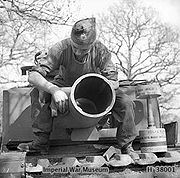
| I | |||||||||||||||||||||||||||||||||||||
| II | |||||||||||||||||||||||||||||||||||||
| OKE | IIcs | ||||||||||||||||||||||||||||||||||||
| III/IV | |||||||||||||||||||||||||||||||||||||
| AVRE | 75mm | VI | V | ||||||||||||||||||||||||||||||||||
| ARK | X | XI | IX[LT] | ||||||||||||||||||||||||||||||||||
| VII | |||||||||||||||||||||||||||||||||||||
| Crocodile | VIII | ||||||||||||||||||||||||||||||||||||
Tanks
With number produced
Churchill I (303)
- Equipped with a 2 pounder gun in the turret (150 rounds), and a coaxial Besa machine gun. There was a 3 inch howitzer in the hull (58 rounds). It was a tank that was noted for poor mechanical reliability. It was the main tank issued to the Canadian forces at Dieppe.
Churchill Mk II (1,127)
- Replaced the hull howitzer for another machine gun to reduce cost and complexity. Sometimes referred to as Churchill Ia.
Churchill Mk IICS (Close Support)
- Placed the gun in the hull and the howitzer in the turret, available in very limited numbers. Sometimes called Churchill II.
Churchill Mk III (675)
- The III was the first major armament overhaul of the series, eliminating the hull howitzer and equipping the tank with a more powerful 6 pounder gun (84 rounds). Unlike early versions, it had a welded turret.
Churchill Mk IV (1,622)
- The IV was the most numerous Churchill produced, and was virtually identical to the III, the largest change being a return to the less costly cast turret.
Churchill Mk V (241)
- A Churchill III / IV which was equipped with a close support 95 mm howitzer in place of the main gun (47 rounds).
Churchill Mk VI (200)

- Along with several minor improvements, it was produced as standard with the 75 mm Mk V gun. Few were built due to the near release of the VII and current upgunning of the III / IV.
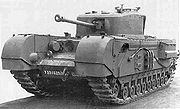
Churchill Mk VII (A22F) (1,600 with VIII)
- The second major redesign from previous models, the VII used the 75 mm gun, was wider and had much more armour. It is sometimes called the Heavy Churchill. This version of the Churchill first saw service in the Battle of Normandy, and was re-designated A42 in 1945.
Churchill Mk VIII
- A Churchill VII which replaced the main gun with a 95 mm howitzer (47 rounds).
Refitted previous versions:
Churchill Mk IX
- Churchill III / IV upgraded with turret of the VII. Extra armour added along with gearbox and suspension modifications. If the old 6 pounder had been retained, it would have the additional designation of LT ("Light Turret").
Churchill Mk X
- The same improvements as for the IX applied to a Mk VI.
Churchill Mk XI
- Churchill V with extra armour and Mk VIII turret.
Specialist vehicles
Churchill Oke (3)
A Churchill II or III with a flamethrower. The Oke flamethrowing tank was named after its designer, Major J.M. Oke. The design was basically for a Churchill tank fitted with the Ronson flamethrower equipment. A tank containing the flame fuel was fitted at the rear, with a pipe from it leading to the mounting on the front hull to the left, leaving the hull machine gun unobstructed. There were three (named "Boar", "Beetle" and "Bull") present at Dieppe which were quickly lost, and abandoned.
Churchill NA75 (120)
Churchill III / IV with upgraded weaponry using the turret and mantlet from a destroyed or scrapped Sherman (known as NA 75 from North Africa where the conversions took place), or having their current gun re-bored to 75 mm (III* / IV (75 mm) ) (84 rounds). More IVs were modified than IIIs, and their performance is virtually identical to the VI. To fit the Sherman mantlet required cutting away the front of the Churchill turret before it was welded in place, then the mantlet slot had to be cut away to give sufficient elevation. The Sherman 75 mm gun was designed for a left hand loader and the Churchill in common with British practice had a right hand loader. The gun was therefore turned upside down and the firing controls adapted. [9]
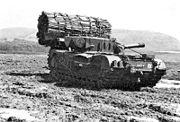
Churchill AVRE (Armoured Vehicle Royal Engineers)
A Churchill III or IV equipped with the Petard, a 290 mm Spigot mortar, throwing the 40 lb (18 kg) "Flying dustbin" with its 28 pound high explosive warhead; a weapon designed for the quick levelling of fortifications developed by MD1. The AVRE was designed after the Canadian defeat at Dieppe, and could also be equipped with numerous other attachments, such as mine flails, fascine rollers, explosive placers etc. Post war the Churchill AVRE was re-armed with a breech-loaded low velocity 165mm demolition gun which was less dangerous for the loader (the hull gunner) as he previously had to stick his head and torso out of the Spigot Mortar armed AVRE to load the Mortar. The crew of six were drawn from the Royal Engineers, except for the driver who came from the Royal Armoured Corps. One of the RE crew was a demolitions NCO sapper responsible for priming the "Flying dustbin" and who led the crew when they dismounted from the tank to place demolition charges ("Wade" charges).
Churchill ARV (Armoured Recovery Vehicle)
Mk I - A turretless Mk I with a jib. Mk II - A Churchill with a fixed turret/superstructure with a dummy gun. It was equipped for recovering other tanks from the battlefield. Mounted a front jib with a 7.5 ton capacity, a rear jib rated for 15 ton and winch that could pull 25 ton. Crew was 3 with enough room to carry the crew of the tank being recovered. Armament was single Besa machine gun.
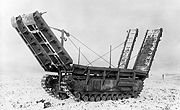
Churchill ARK (Armoured Ramp Carrier)
A turretless Churchill with ramps at either end and along the body to form a mobile bridge. The Mark 1 had trackways over the tracks for vehicles to drive along. The Mark 2 was an improvised version and crossing vehicles drove directly on the Churchill's tracks. the Link Ark (or "Twin Ark") was two ARKs used side-by-side to give a wide crossing. The ramps on these were folding types giving a longer - 65 ft (20 m) - crossing.[10] This was used for the post war Conqueror heavy tank.
Churchill Crocodile (no more than 800[11])
The Crocodile was a Churchill VII which was converted by replacing the hull machine gun with a flamethrower. The fuel was in an armoured wheeled trailer towed behind. It could fire several 1 second bursts over 150 yards. The Crocodile was one of "Hobart's Funnies" - another vehicle used by the 79th Armoured Division. A working example can still be seen at the Cobbaton Combat Collection in North Devon.
Gun Carrier, 3in, Mk I, Churchill (A22D) (50)
A fixed superstructure with the gun in a ball mount. Fifty were built in 1942 but none are known to have been used - the 17 pounder anti-tank gun gave the British the necessary firepower.
Churchill Flail FV3902 or Toad
A post-war (1950s) mine-clearing flail tank built on a Churchill chassis.
Churchill Goat
A chargelayer like the Double Onion device.
- Churchill Great Eastern
A much larger longer ramp than the ARK for crossing 60 ft. The ramp was launched into position with rockets. Ten built and two delivered in 1945 but not used in action.[12]
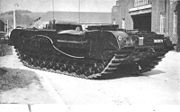
Churchill Kangaroo
Churchill hull converted to an APC.
 Churchill Crocodile |
 A close-up of the Churchill AVRE's Petard demolition mortar |
Designs based on chassis
In 1943 an attempt was made to up-gun the Churchill by using Heavy Churchill tanks modified to take a 17 pounder gun, as was done with the Sherman Firefly. This resulted in the Tank, Infantry, Black Prince (A43) in May 1945. Six prototypes were built, but the project was cancelled due to the emergence of the new and less complicated Centurion Mk1 which offered the same armament and armour and had just entered production.
Operators
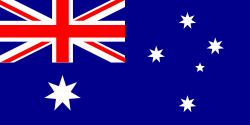 Australia retired, replaced with the Centurion tank
Australia retired, replaced with the Centurion tank Canada retired, replaced with the Centurion tank
Canada retired, replaced with the Centurion tank Ireland retired in 1969, replaced with the Comet tank
Ireland retired in 1969, replaced with the Comet tank Poland (Polish Armed Forces in the West) retired in 1947, no replacement
Poland (Polish Armed Forces in the West) retired in 1947, no replacement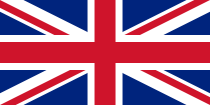 United Kingdom retired, replaced with the Centurion tank
United Kingdom retired, replaced with the Centurion tank Soviet Union (Lend-Lease) retired, replaced with IS-3 and T-10 tanks
Soviet Union (Lend-Lease) retired, replaced with IS-3 and T-10 tanks
Notes
- ↑ TOAD Flail in reserve for British Army until mid 1960s
- ↑ Fletcher p21
- ↑ Perrett, p. 4
- ↑ Fletcher p 21, p 58
- ↑ who was also responsible for the triple differential design of the Merritt-Brown gearbox used in the Churchill
- ↑ 6.0 6.1 "Fabrication of the new Churchill Tank, MK VII"
- ↑ Fletcher p59
- ↑ KingForce
- ↑ Perrett, p. 9
- ↑ http://www.remuseum.org.uk/articles/rem_article_assaultbridge.htm
- ↑ 800 Crocodile conversion kits were produced. Delaforce p. 71
- ↑ Chris Shillito. "Churchill Great Eastern Ramp". Armourinfocus.co.uk. http://www.armourinfocus.co.uk/a22/ge/index.htm. Retrieved 2010-03-06.
References
- Chant, Christopher (1997). An Illustrated Data Guide to Battle Tanks of World War II. London: Chelsea House Publications. ISBN 9781855018563.
- Delaforce, Patrick (2006). Churchill's Secret Weapons: the story of Hobart's Funnies. Barnsley: Pen & Sword. ISBN 1 84415 464 5.
- Perrett, Bryan; Sarson, Peter; Chappell, Mike (1993). Churchill Infantry Tank 1941-1945. Osprey Publishing. ISBN 9781855322974.
- "Fabrication of the new Churchill Tank, MK VII". www.royaltankregiment.com. The Royal Tank Regiment Association. http://www.royaltankregiment.com/9_RTR/tech/welded%20churchill/Armour%20welding%20on%20Mark%20VII.htm.
External links
- Churchill tank restoration project
- Churchill Tank development and technical data
- Armour in Focus
- Henk of Holland
- LemaireSoft
- OnWar specifications: Churchill I Churchill IV Churchill VII
- Development of the Churchill
- WWII Vehicles
- Churchills in Soviet Union
- "Churchill" Heavy Infantry Tank in the Russian Battlefield
- Detailed vehicle description at 9th Battalion, Royal Tank Regiment website
- Detailed history of the 9th Battalion, using Churchills from introduction to war's end
- Memories of Frank Meredith, 9th Battalion Driver/Mechanic 1942-1945
|
|||||||||||
|
|||||
|
|||||
|
|||||||||||||||||
|
|||||
|
||||||||||||||
| British armoured fighting vehicle production during World War II |
|---|